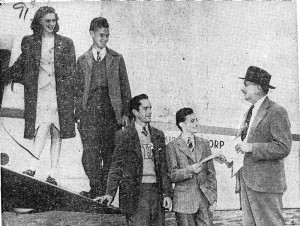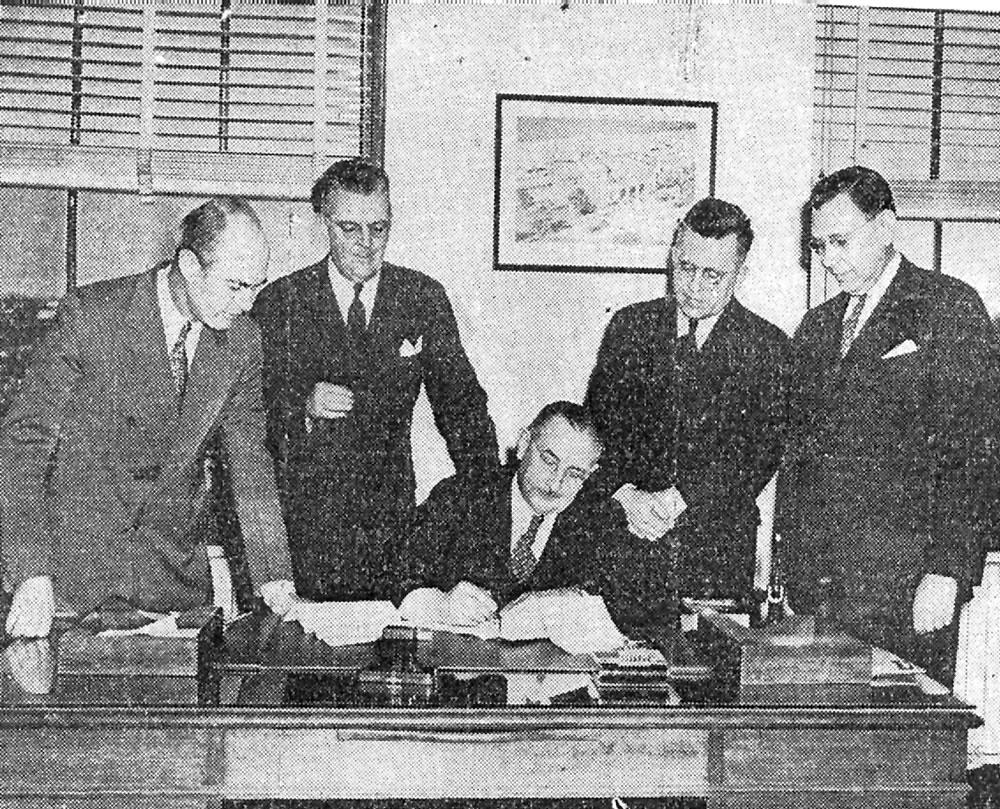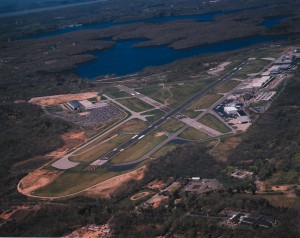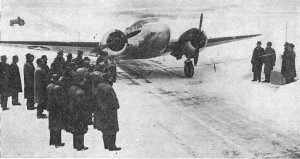By Esther H. Forbes, U.S. Air Services, March 1945

(Jan. 17, 1945 – New Rochelle NY Standard Star) Westchester signed for commercial operation of its Rye Lake Airport yesterday.
One of the first of the 600 airports that the Civil Aeronautics Administration has built since 1940… for national defense was formally dedicated for civilian flying at the Westchester County Airport on February 13.
Situated on Rye Lake, five miles from White Plains, N.Y., it is officially designated as a Class-4 airport and can thus accommodate any private or commercial plane in existence today. Its three large runways are 150 ft. wide and 5,000 ft., 4,750 ft. and 4,450 ft. long, respectively. Two are paved with concrete and the other with black top. All have been built with firm foundations to be able to serve such heavy military planes as Liberators and Flying Fortresses.
When finished, the airport will represent an investment of some $5,000,000. It is owned by Westchester County, which appropriated $300,000 to buy the site. It was constructed by the CAA, which spent more than $3,500,000 of Federal funds for grading and paving the runways, and equipping the field with 8,900 feet of concrete taxiways, a parking apron, a system of contact lights, and many miles of storm drains. It will be operated by the North American Airport Corporation, which… has agreed to spend about $900,000 for the construction of buildings and other facilities that the county will buy back at the end of the contract.
At a luncheon given before the dedication ceremonies Edward C. Rowe, president of North American, outlined the plans of the company, which was organized with the backing of the Gulf Oil Corporation specifically for the operation of the airport. At present, there is only one building at the airport—a small hangar being used for experimental purposes by a radio company. However, as soon as the weather and war conditions permit, the company plans to construct temporary hangars and start activity.
After that, it will build a large modern administration building designed as an aviation and county center. In addition to a restaurant and café… the building will provide recreational facilities of many sorts.
The contract between Westchester County and North American that will be in place until 15 years after the war provides that North American will pay the county for the concession 7.5 percent of its gross receipts and guarantees a minimum payment of $480,000. North American, in turn, has signed a contract with Gulf Oil for the gasoline concession.
So far, the airport has seen little flying. Although designed as an interceptor base, it was never used as such by the Army. Actually, its chief use until now, according to Herbert C. Gerlach, Westchester County executive, has been as an auxiliary field where American Airlines pilots have practiced takeoffs and landings.
As a civilian flying field, it got off to a memorable start by becoming what is probably the first airport ever to be dedicated in a blinding blizzard.
The storm completely disrupted the plans for the ceremony, which had called for the dedication address to be delivered by Charles I. Stanton, deputy administrator of the CAA, and the ribbon to be cut by a plane swooping down over the 5,000-ft. runway. Mr. Stanton’s plane was grounded in Washington and he arrived in White Plains too late for the dedication…
Commenting on the significance of the airport for postwar flying, Mr. Stanton predicted during a press conference that there will be more than 350,000 planes in the United States five years after the war, and went so far as to say “we can expect 35,000 to 40,000 planes in metropolitan New York.”
Mr. Stanton also made several calculations about the economics of postwar aviation. There are about 5,000,000 potential flyers in this country, he said, including some 2,500,000 service men trained in some phase of aviation, either as flyers or ground crews, and an equal number of men and women now working in aircraft factories.
“If 30 to 40 percent of them learn to fly, the number of flyers in this country will be substantial. If two million of these persons fly only one hour a week, or 50 hours a year, at a cost of $5 an hour, that in itself will represent $500,000,000 a year.”
As proof that there is already a definite demand for flying instruction, Mr. Stanton said that the CAA has had a veritable flood of applications for student permits, which reached about 2,000 a week in the latter part of 1944.
For the aircraft industry itself, Mr. Stanton foresees a reasonably bright future.
“Mr. Krug of the WPB recently estimated,” he pointed out, “that the postwar aircraft production will be about one billion dollars annually. This compares with twenty billion dollars annually of aircraft production during the last two years. However, more than 48 percent of the present aircraft production comes from firms that do not normally work on aircraft manufacturing. The stored-up demand for many miscellaneous items will cause these companies to return to their lines of business after the war. This would mean that roughly $10 billion of aircraft is being produced today by the actual aircraft business.

At the County Airport, County Executive Herbert C. Gerlach gives Hugh E. Hutchinson (second from left) a certificate of his rank as “General” in Westchester County for selling the most war bonds during the Seventh War Loan drive.
“In normal times, the aircraft business would be on a one-shift basis. At present, it is working on a two-shift or more daily basis. So on a normal peacetime working basis, the present aircraft production facilities could produce about $5 billion worth annually. Therefore, in looking for a billion-dollar-a-year aircraft production rate, we find the comparison between war production and peace production is close to a reduction from 5 to 1 than from 20 to 1, as might at first appear.”
Blizzard Sweeps Airport as It is Formally Dedicated to Civilian use After War Chief Guest Arrives Late
Special to the New York Times, Feb. 13, 1945
Westchester County’s $4,000,000 airport was formally dedicated today… County officials and oil company executives shivered in the lashing gale for two hours before a plane could be moved through drifted snow to the dedication marker, where the spinning propellers cut through a ribbon that spanned the runway.
The plane, a C-45, was piloted by Lt. Morey Weisman of the Army Air Forces, assisted by Richard K. Benson, airport manager. At the marker, in the snow, were County Executive Herbert C. Gerlach and Gulf officials. Fifty county and company officials were near by. …
“I believe, although perhaps I shouldn’t tell Mayor La Guardia,” Mr. Stanton said, “that after the war, when air lines can get all the planes they need, some transport planes flying to Boston, Washington and other places will make the Westchester airport a terminal or at least make stops there.”














